当前位置:
X-MOL 学术
›
Macromol. Chem. Phys.
›
论文详情
Our official English website, www.x-mol.net, welcomes your
feedback! (Note: you will need to create a separate account there.)
Self‐Healing Metallo‐Supramolecular Amphiphilic Polymer Conetworks
Macromolecular Chemistry and Physics ( IF 2.5 ) Pub Date : 2020-01-13 , DOI: 10.1002/macp.201900432 Clément Mugemana 1 , Patrick Grysan 1 , Reiner Dieden 1 , David Ruch 1 , Nico Bruns 2 , Philippe Dubois 3
Macromolecular Chemistry and Physics ( IF 2.5 ) Pub Date : 2020-01-13 , DOI: 10.1002/macp.201900432 Clément Mugemana 1 , Patrick Grysan 1 , Reiner Dieden 1 , David Ruch 1 , Nico Bruns 2 , Philippe Dubois 3
Affiliation

|
The current challenge in self‐healing materials resides in the design of materials which exhibit improved mechanical properties and self‐healing ability. The design of phase‐separated nanostructures combining hard and soft phases represents an attractive approach to overcome this limitation. Amphiphilic polymer conetworks are nanostructured materials with robust mechanical properties, which can be tailored by tuning the polymer composition and chemical functionality. This article highlights the design of phase‐separated nanostructured polymers from metallo‐supramolecular amphiphilic polymer conetworks, and their application for self‐healing surfaces. The synthesis of poly(N‐(pyridin‐4‐yl)acrylamide)‐l‐polydimethylsiloxane polymer conetworks from the poly(pentafluorophenyl acrylate)‐l‐polydimethylsiloxane activated ester is presented. Loading of ZnCl2 salt into the phase‐separated polymer conetwork strengthens the network by cross‐linking the poly(N‐(pyridin‐4‐yl)acrylamide) phases, while offering reversible interactions needed for self‐healing ability.
中文翻译:

自修复金属超分子两亲聚合物共网络
自愈材料目前的挑战在于设计出具有改善的机械性能和自愈能力的材料。结合了硬相和软相的相分离纳米结构的设计是克服此局限性的一种有吸引力的方法。两亲性聚合物共网络是具有鲁棒机械性能的纳米结构材料,可以通过调整聚合物组成和化学功能来进行定制。本文着重介绍了由金属-超分子两亲性聚合物网络组成的相分离纳米结构聚合物的设计及其在自修复表面上的应用。由聚(五氟苯基丙烯酸酯)-合成聚(N-(吡啶-4-基)丙烯酰胺)-1-聚二甲基硅氧烷聚合物共网络介绍了l-聚二甲基硅氧烷活化的酯。将ZnCl 2盐加载到相分离的聚合物共网络中,可以通过交联聚N-(吡啶-4-基)丙烯酰胺相来增强网络,同时提供自愈能力所需的可逆相互作用。
更新日期:2020-01-13
中文翻译:

自修复金属超分子两亲聚合物共网络
自愈材料目前的挑战在于设计出具有改善的机械性能和自愈能力的材料。结合了硬相和软相的相分离纳米结构的设计是克服此局限性的一种有吸引力的方法。两亲性聚合物共网络是具有鲁棒机械性能的纳米结构材料,可以通过调整聚合物组成和化学功能来进行定制。本文着重介绍了由金属-超分子两亲性聚合物网络组成的相分离纳米结构聚合物的设计及其在自修复表面上的应用。由聚(五氟苯基丙烯酸酯)-合成聚(N-(吡啶-4-基)丙烯酰胺)-1-聚二甲基硅氧烷聚合物共网络介绍了l-聚二甲基硅氧烷活化的酯。将ZnCl 2盐加载到相分离的聚合物共网络中,可以通过交联聚N-(吡啶-4-基)丙烯酰胺相来增强网络,同时提供自愈能力所需的可逆相互作用。











































 京公网安备 11010802027423号
京公网安备 11010802027423号